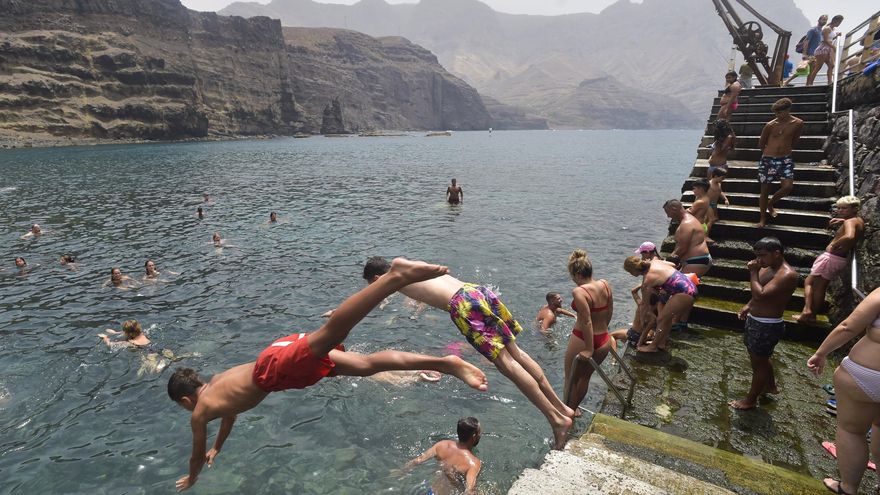
The Ministry of Health of the Government of the Canary Islands, through the General Directorate of Public Health, activates health risk notices in different municipalities of Gran canaria and Tenerife in which there is a forecast of exceeding the threshold temperatures in the coming days (32 degrees maximum and 24 degrees minimum, simultaneously) established in the Plan of Preventive Actions of the Effects of Excessive Temperatures on Health.
In red warning of risk for the health it is of the September 8 to 12 the municipality of Santa Lucia de Tirajana, in Gran Canaria.
In orange notice of September 9 to 12 will be Agüimes, Ingenio, Mogán, San Bartolomé de Tirajana and Tejeda, in Gran Canaria. They will also be in orange notice of the 9 to 11 September the Gran Canaria municipalities of Agaete, Village of San Nicolás and Artenara and the September 9 the municipalities of Arona, San Miguel de Abona and Granadilla, in Tenerife. In yellow notice will be the day September 9 the municipality of Valsequillo, in Gran Canaria.
recommendations
The General Directorate of Public Health sends the affected municipalities, through the FECAM, a reminder of the measures they must adopt to protect the health of the most fragile members of their community:
-Drink a lot of water or fluids without waiting to be thirsty, unless there is a medical contraindication. Avoid alcoholic beverages and highly sugary ones.
-Avoid exposing yourself to the sun at the hours of greatest intensity of heat (between 11 a.m. and 4 p.m.), doing it preferably before 11 o’clock or after 4 p.m.
-In the hottest hours, place yourself in the coolest areas of the houses or residences, or if necessary place ventilation or air conditioning devices, or lastly use fresh damp cloths or take a shower.
-Avoid sports activities, excursions or visits abroad in the hottest hours. Do these activities in the early hours of the day, late in the afternoon or at night; Protect yourself from the sun and drink plenty of beverages that replace fluids and mineral salts (juices, isotonic drinks, water, etc.).
-Make light meals that help replace the salts lost through sweat (salads, fruits, vegetables, gazpachos or juices).
-If you have to go outside, try to be in the shade, wear light and light-colored clothing, protecting yourself from the sun with approved hats or caps and sunglasses. Wear cool, comfortable and breathable footwear.
-Be careful with medicines, especially those that must be in the fridge for proper conservation.
-Always maintain the cold chain of food.
In the case of presenting any symptoms associated with heat such as headaches, dizziness, cramps, general malaise, a feeling of suffocation due to heat, fatigue or exhaustion, contact 112.
These actions are intended to increase the individual prevention capacity to cope with the heat by applying measures that are easy and accessible. The plan is aimed at the entire population, and especially designed for the population groups most vulnerable to intense heat such as the elderly, children and people with chronic diseases.
From a social point of view, marginalization, isolation, dependency, disability, the living conditions of people with fewer resources, add risk factors that make groups even more vulnerable, precisely because of their socio-economic conditions. , they should be more supported.
Specifically, all hospitals and the Canary Islands Emergency Service (SUC) have specially designated and trained personnel to effectively cope with and coordinate services in the event of a possible heat wave, as well as the established communication channels.
Temperature thresholds and risk levels
To be able to speak of a warning of health risk due to heat in the strict sense, maximum and minimum temperature must be reached simultaneously. This is known as temperature thresholds, which are set each year by the State Meteorological Agency. For the two Canarian provinces the temperature threshold is 32 degrees maximum and 24 degrees minimum.
The Plan for the Prevention of the Effects of High Temperatures on People’s Health establishes four different levels of health risk, depending on the expected temperatures and their duration in time.
Other preventive plans in the Canary Islands
Faced with a situation of maximum temperatures, the Government of the Canary Islands can activate this Plan for the Prevention of the Effects of High Temperatures on the Health of People, with a warning of health risk, as well as its Specific Plan for Civil Protection and Care of Emergencies of the Autonomous Community of the Canary Islands for Risks due to Adverse Meteorological Phenomena (PEFMA), through the declaration of alert for risk situations for the population, property and the environment.
















